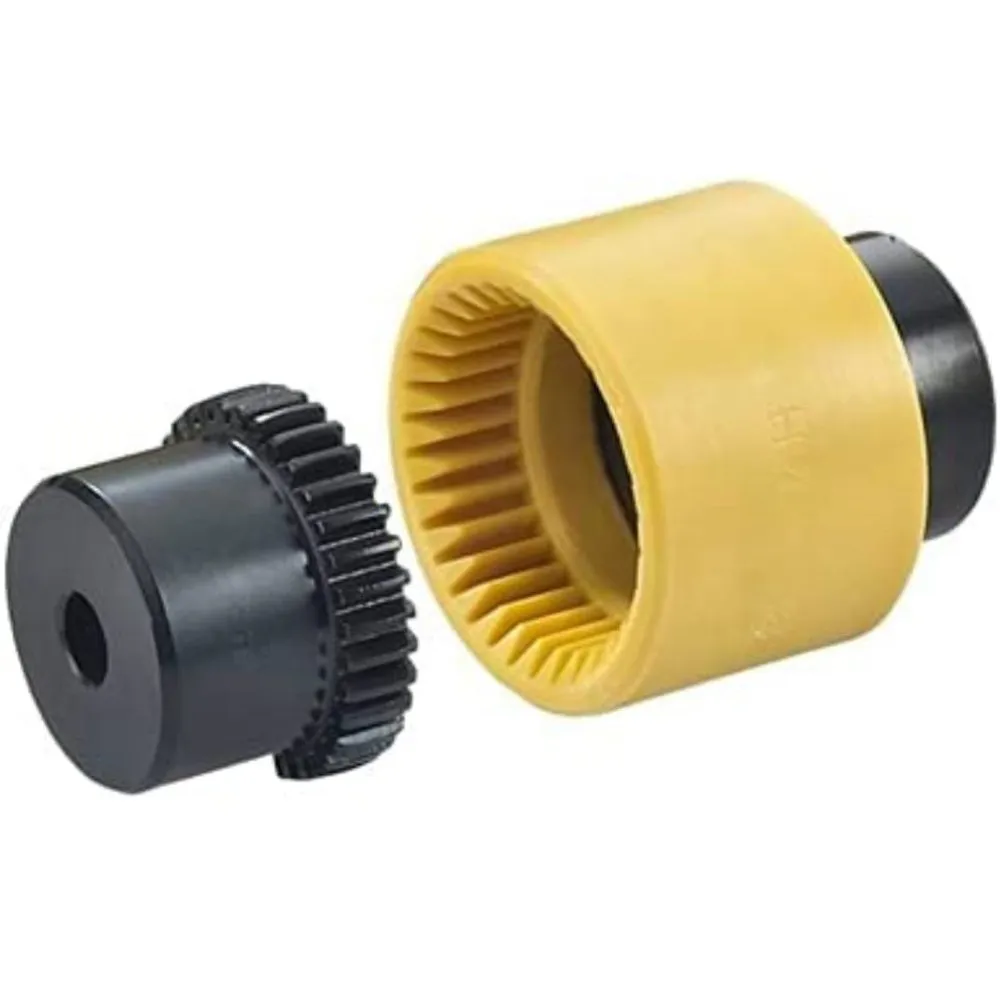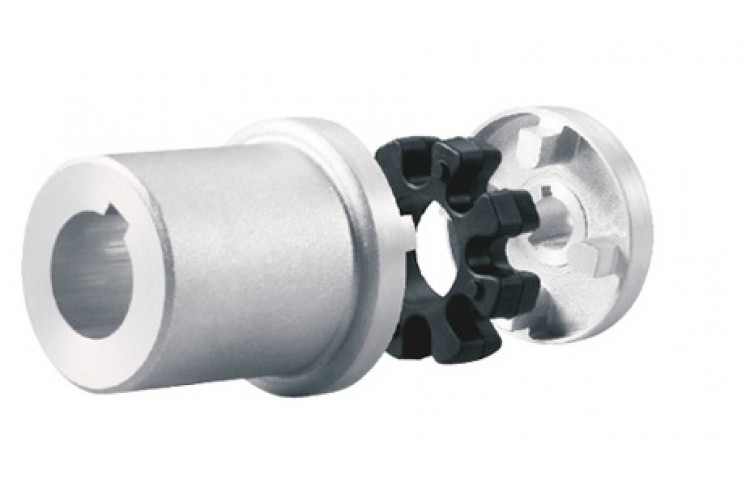Product Description
Large Torque Coupling Drive Plum Shaped Nylon Spider Flexible Spider Jaw Rubber Coupling for Chemical Industry Use
Manufacturer of Couplings, Fluid Coupling, JAW Coupling, can interchange and replacement of lovejoy coupling and so on.
A coupling can interchange and replacement of lovejoy coupling is a device used to connect 2 shafts together at their ends for the purpose of transmitting power. The primary purpose of couplings is to join 2 pieces of rotating equipment while permitting some degree of misalignment or end movement or both. In a more general context, a coupling can also be a mechanical device that serves to connect the ends of adjacent parts or objects. Couplings do not normally allow disconnection of shafts during operation, however there are torque limiting couplings which can slip or disconnect when some torque limit is exceeded. Selection, installation and maintenance of couplings can lead to reduced maintenance time and maintenance cost.
Coupling is a jaw type coupling that works for a variety of light duty to heavy duty motors used in electric power transmission.
This is 1 of our safest types of products. The reason being that these couplings work even when the elastomer fails and there is no metal to metal contact.
They perform in well-standing oil, grease, moisture, sand, and dirt and nearly 850,000 bore combinations that can be customised as per the customer’s needs.
They are used in light-weight, medium, or heavy electrical motors and devices for power transmission through internal combustion.
Features
1. Hubs made of cast iron GG25.
2. Torsionally flexible, maintenance free, vibration-damping.
3. Axial plug-in, fail-safe.
4. Varying elastomer hardness of spiders.
5. Compact design with small flywheel effect.
6 Easy assembly / dis-assembly of the coupling hubs Short mounting length.
Production workshop:
Company information:

Explaining the Concept of Backlash and How It Affects Drive Coupling Performance
Backlash is a mechanical phenomenon that refers to the amount of free movement or play between the mating components of a drive system. In the context of drive couplings, backlash is the angular or linear displacement that occurs when there is a change in direction or a reversal of motion. It is mainly a result of clearances between the coupling’s mating elements.
The presence of backlash can have both positive and negative effects on drive coupling performance:
- Negative Effects of Backlash:
- Reduced Accuracy: Backlash can introduce inaccuracies in position control systems, especially in applications requiring precise positioning. The free movement between the coupling elements can result in a delay in response when the direction of rotation changes, leading to positioning errors.
- Vibration and Noise: Backlash can cause vibration and noise during operation, especially in systems with frequent changes in direction or load. The impact and collision of the mating elements can generate noise and contribute to mechanical wear.
- Increased Wear: In systems with significant backlash, the constant impact between the mating components can accelerate wear and reduce the lifespan of the coupling and other connected machinery.
- Positive Effects of Backlash:
- Shock Absorption: In certain applications, a controlled amount of backlash can act as a shock absorber, dampening sudden impact loads and reducing stress on the system during abrupt changes in motion.
- Misalignment Compensation: Backlash can compensate for minor misalignments between shafts, reducing the risk of damage and excessive load on the coupling and connected components.
- Thermal Expansion Compensation: Backlash can help accommodate thermal expansion and contraction of the components, allowing the coupling to function effectively even as the temperature changes.
The appropriate amount of backlash depends on the specific application and the coupling type. In some cases, minimizing backlash is essential for precision and accuracy, while in others, a controlled amount of backlash can be beneficial for shock absorption and misalignment compensation.
It’s crucial to consider the effects of backlash when selecting a drive coupling and designing a power transmission system. Manufacturers often provide information on the level of backlash in their coupling designs, enabling users to make informed decisions based on their application’s requirements.

Understanding the Torsional Stiffness and Damping Characteristics of Drive Couplings
Torsional stiffness and damping are essential characteristics of drive couplings that play a significant role in the performance and behavior of mechanical power transmission systems. Let’s explore these two properties:
Torsional Stiffness:
Torsional stiffness refers to the ability of a drive coupling to resist angular deflection or twisting when subjected to a torque load. It is a measure of the coupling’s rigidity and is typically represented by a spring constant. A coupling with high torsional stiffness will exhibit minimal angular deflection when torque is applied, providing a more direct transfer of rotational power. On the other hand, a coupling with lower torsional stiffness allows for some flexibility and misalignment tolerance.
Drive couplings with high torsional stiffness are commonly used in applications where precision and accurate torque transmission are crucial, such as precision machinery and high-speed power transmission systems. Couplings with lower torsional stiffness are employed in situations where flexibility and shock absorption are needed to protect connected components from sudden torque spikes and vibrations.
Torsional Damping:
Torsional damping characterizes the ability of a drive coupling to dissipate energy in the form of heat when subjected to torsional vibrations. Damping reduces the amplitude of vibrations and prevents resonance, which can be detrimental to the coupling and the entire power transmission system.
Drive couplings with adequate torsional damping can absorb and dampen torsional vibrations, preventing excessive wear on the coupling and the connected machinery. The damping capacity of the coupling is determined by its material properties and design. High torsional damping is especially important in applications where the drive system experiences varying torque loads and vibrations, as it helps maintain stability and extends the life of the coupling and other mechanical components.
Both torsional stiffness and damping are critical factors to consider when selecting a drive coupling for a specific application. The appropriate coupling choice will depend on the desired level of rigidity, flexibility, and vibration absorption required for the mechanical power transmission system.

Can a Damaged Drive Coupling Lead to Transmission Issues in Vehicles?
Yes, a damaged drive coupling can lead to transmission issues in vehicles. Drive couplings are critical components that connect the engine to the transmission and other drivetrain components, allowing the transfer of power and torque. When a drive coupling is damaged or worn, it can negatively affect the performance and reliability of the entire transmission system. Here are some ways in which a damaged drive coupling can lead to transmission issues:
- Power Loss: A damaged drive coupling may not efficiently transfer power from the engine to the transmission. This can result in a loss of power, leading to reduced acceleration and overall vehicle performance.
- Transmission Slippage: When a drive coupling is damaged, it may not provide a secure connection between the engine and the transmission. This can lead to transmission slippage, where the transmission fails to engage properly, causing the vehicle to hesitate or slip out of gear while driving.
- Increased Transmission Wear: A damaged drive coupling can cause vibrations and misalignments in the drivetrain, leading to increased wear on the transmission components. Excessive wear can result in premature failure of transmission gears, bearings, and other critical parts.
- Difficulty in Shifting Gears: A faulty drive coupling may result in difficulty shifting gears, making it hard for the driver to smoothly transition between different gears. This can lead to jerky gear shifts and impact the vehicle’s overall drivability.
- Strange Noises: A damaged drive coupling may produce unusual noises, such as clunking, rattling, or grinding sounds, indicating a problem in the drivetrain. These noises can be a warning sign of potential transmission issues.
- Overheating Transmission: If a drive coupling is not functioning correctly, it may cause the transmission to work harder to compensate for the power loss. This increased workload can lead to overheating of the transmission fluid, potentially causing damage to internal components.
- Transmission Fluid Leaks: In some cases, a damaged drive coupling can cause leaks in the transmission system. Transmission fluid leaks can result in a loss of fluid, leading to decreased lubrication and potential damage to the transmission.
- Poor Fuel Efficiency: A malfunctioning drive coupling can contribute to poor fuel efficiency since the engine may not efficiently transfer power to the transmission and wheels, leading to increased fuel consumption.
It is essential to regularly inspect and maintain the drive coupling and other transmission components to prevent potential issues. If any signs of damage or wear are noticed, it is crucial to address the problem promptly and replace the damaged drive coupling to avoid further transmission problems and ensure the vehicle’s safe and smooth operation.


editor by CX 2023-09-07
